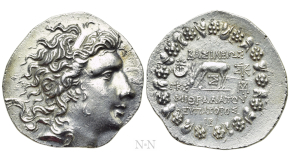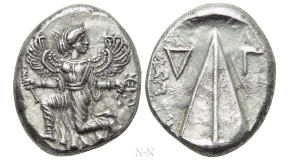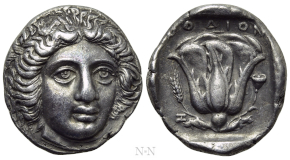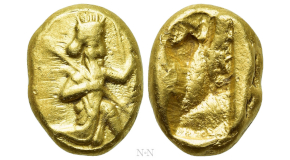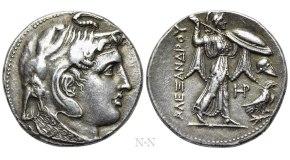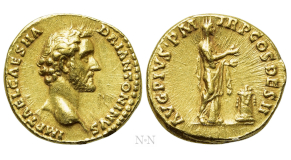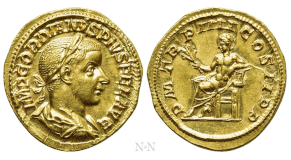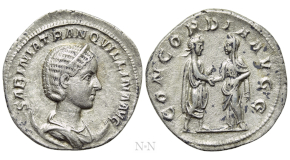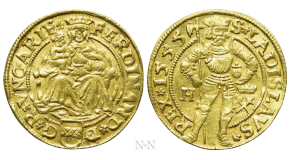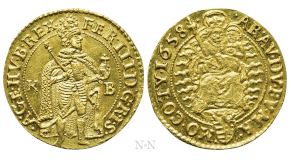
Auktion Nr. 152
Antike und moderne Münzen (Lose 1-1597)
Das Live bidding startet am 04. Mai 2025 ab 17:00 Uhr
First Sunday of the month is Naumann Sunday!
Münzen der Griechen
★ Mint State Mithradates ★
KINGS OF PONTOS. Mithradates VI Eupator (Circa 120-63 BC). Tetradrachm. Pergamon. Dated month 12, year 223 (September 74 BC).
Obv: Diademed head right.
Rev: ΒΑΣΙΛΕΩΣ / ΜΙΘΡΑΔΑΤΟΥ ΕΥΠΑΤΟΡΟΣ.
Stag grazing left; to left, star-in-crescent above ΓΚΣ (year); two monograms to right, Σ below, IB (month) in exergue; all within Dionysiac wreath of ivy and fruit.
Callataÿ pp. 21-2; DCA 692; HGC 7, 340.
Very rare.
Condition: Mint State.
Weight: 16.39 g.
Diameter: 33 mm.
Münzen der Griechen
★ Outstanding Kaunos Stater ★
CARIA. Kaunos. AR Stater (Circa 410-390 BC).
Obv: Winged female figure in kneeling-running stance left, head right, holding kerykeion and wreath.
Rev: Triangular baetyl with a central ridge; inverted Δ and Γ across upper field; all within shallow square incuse.
Konuk 111-116; SNG von Aulock 2350; SNG Kayhan I, 799; HN Online 5.
Condition: Extremely fine.
Weight: 11.73 g.
Diameter: 23 mm.
Münzen der Griechen
★ Superb Tetradrachm ★
CARIA. Rhodes. Tetradrachm (Circa 408-400 BC).
Obv: Bare head of Helios facing slightly right.
Rev: POΔION.
Rose with bud to right; to left, grain ear above letter Z; all within square incuse.
HN online 1028; Bérend 1972, 56; HGC 6, 1418.
Rare.
The tetradrachm is dated to Rhodes‘ most glorious period, with the founding of the new city beginning in 408 BC. According to tradition, the origin of Rhodes has always been linked to the sun god Helios and the flower sacred to him, the rose, which appear on the majority of coins struck by the mint. According to Pindar Helios and the nymph Rhoda had seven children, among whom Cercaphus divided the island of Rhodes among his three sons, Ialysos, Camirus, and Lindos. Rhodes was invaded in 490 by the Persians and, after their defeat, became part of the Delio-Attic League (478), supporting the Athenians against the growing Persian threat. The Rhodians exited the alliance in 411, during the Peloponnesian War. In 408 the island’s three cities decided to establish a new religious and commercial centre at the northernmost point of the island, designed by the famous Hippodamus of Miletus, who provided it with a regular layout with sturdy city walls that were state-of-the-art for the time, and five harbors. This made the city a powerful economic centre and one of the major trading centers of the eastern Mediterranean.
Condition: Good very fine.
Weight: 15.44 g.
Diameter: 25 mm.
Münzen der Griechen
ACHAEMENID EMPIRE. Time of Darios I to Xerxes II (Circa 485-420 BC). GOLD Daric. Sardes.
Obv: Persian king in kneeling-running stance right, holding spear and bow, with quiver over shoulder.
Rev: Rectangular incuse punch.
Carradice Type IIIb; GRPC G61; SNG Copenhagen 274-5; Sunrise 24; BMC Arabia 40-3.
Although it is believed that the earliest Staters in Lydia are really to be attributed to Kroisos, the most recent series should be dated to the time of Persia’s conquest of the region. From the end of the 6th century BC, gold Darics and silver Sigloi appear, marked by the type of the archer king and struck for decades in the mint of Sardis. The name ‚Daric‘ assigned to the Persian gold stater is already found in Herodotus and is mentioned in an Athenian document from 429 BC. These were well known coins in Greek environments, intended to circulate in a huge empire and therefore struck in large quantities. Gold was used by Persian kings as prestige currency, for donations and for large payments, for example to pay Greek mercenaries in their service. This is why many specimens of these staters have been found in Greece and Sicily. The Golden Daric was worth 20 silver Sigloi and corresponded as weight to the value of 1/60th of the Persian mina. The king, connoted as a warrior and hunter, is depicted first with a bow and arrows, then while shooting a bow, and finally with a bow and sword. The date of the beginning of the coinage of the Darics and Sigloi is provided by a clay tablet from Persepolis, dated to about 500 BC, on which the image of the ruler while shooting with a bow is imprinted. This type continued to be reproduced until the end of the dynasty, when Darios III was defeated by Alexander the Great in 330 BC.
Condition: Good very fine.
Weight: 8.37 g.
Diameter: 16 mm.
Münzen der Griechen
★ Great Ptolemy Tetradrachm ★
PTOLEMAIC KINGS OF EGYPT. Ptolemy I Soter (As satrap, 323-305 BC). Tetradrachm. Alexandreia. In the name of Alexander III of Macedon.
Obv: Diademed head of the deified Alexander right, wearing elephant skin, aegis around neck; small Δ in scales.
Rev: AΛEΞANΔPOY.
Athena Alkidemos advancing right, holding shield and preparing to cast spear; HP monogram, Corinthian helmet and eagle on thunderbolt to right.
Lorber 65; Svoronos 170; SNG Copenhagen 27.
Condition: Good very fine.
Weight: 15.69 g.
Diameter: 28 mm.
Münzen der Römischen Kaiser
★ Rare Dynastic Aureus ★
TRAJAN, with TRAJAN PATER and NERVA (98-117). GOLD Aureus. Rome.
Obv: IMP TRAIANVS AVG GER DAC P M TR P COS VI P P.
Laureate, draped and cuirassed bust of Trajan right.
Rev: DIVI NERVA ET TRAIANVS PAT.
Busts of Nerva on left, laureate with slight drapery, and Trajan the Elder on right, bareheaded and draped left, facing one another.
Woytek 405f; RIC 726 corr. (obv. legend); Calicó 1138c.
Rare.
Condition: Very fine.
Weight: 7.04 g.
Diameter: 20 mm.
Münzen der Römischen Kaiser
ANTONINUS PIUS (138-161). GOLD Aureus. Rome.
Obv: IMP T AEL CAES HADRI ANTONINVS.
Bare head right.
Rev: AVG PIVS P M TR P COS DES II.
Pietas standing right, holding acerrum and raising hand over lighted and garlanded altar to right.
RIC 13; Calicó 1469.
One of the earliest issues before Antoninus earned the title ‚Pius‘. When Hadrian died, Antoninus took his ashes to Rome and demanded an apotheosis for him; but the Senate objected and threatened ‚damnatio memoriae‘ for Hadrian, who had taken away several privileges from senators in his later years. Antoninus, however, partly thanks to the presence of the army, managed to convince the Senate, granted amnesty to those condemned by his predecessor, and graced those who opposed Hadrian’s apotheosis. Due to his good nature, he was given the title ‚Pius‘.
Condition: Good very fine; luster in field.
Weight: 6.86 g.
Diameter: 18 mm.
Münzen der Römischen Kaiser
★ Mint State Aureus ★
GORDIAN III (238-244). Aureus. Rome.
Obv: IMP GORDIANVS PIVS FEL AVG.
Laureate, draped and cuirassed bust right.
Rev: P M TR P IIII COS II P P.
Apollo seated left, holding branch and resting elbow on lyre.
RIC 102; Calicó 3221.
Born to a daughter of Gordian I, sister of Gordian II, because of the young age at which he came to occupy the throne (13), Gordian did not rule directly, but the Senate did so for him. Gordian had become prince because the Senate needed to placate an uprising of the traditionalist urban plebs, bound to the dynastic ideal, and in order to take advantage of his family’s wealth. Moreover, the praetorians had acclaimed him emperor just to show the Senate that they were the ones who decided who to put on the throne. Among the first moves was the dismissal of the legion in Africa because it had supported Capellianus and led to the deaths of Gordian I and II, who were deified. During his relatively long tenure there were several problems to deal with. In 240 Sabinianus, elected caesar in Carthage, prepared to make war on him, but was stopped by the governor of Mauretania. In the north the barbarians were making constant raids and sacking villages and towns. Gordian was too young to face these problems, but fortunately for him he could count on the diplomatic and military skill of Timesitheus, who had become prefect of the praetorium and granted him his daughter, Tranquillina, in marriage in 241. Rome succeeded in repelling the Persians of Shapur I in 243 thanks to Timesitheus, but on his death he was replaced as prefect of the praetorium by Marcus Julius Philip known as ‚the Arab‘. The latter, however, was not satisfied with this title but aimed at the throne, and he convinced the army that they needed an adult prince and not a boy. Gordian showed maturity and offered to cede the throne to Philip and become his caesar, but he was killed in 244. The Senate was informed that he had died of wounds sustained in a battle against the Persians. His body was sent to Rome where he was deified.
Condition: Mint state, FDC.
Weight: 4.89 g.
Diameter: 20 mm.
Münzen der Römischen Kaiser
★ Tranquillina Antoninianus ★
TRANQUILLINA (Augusta, 241-244). Antoninianus. Rome.
Obv: SABINIA TRANQVILLINA AVG.
Diademed and draped bust right, set on crescent.
Rev: CONCORDIA AVGG.
Gordian III standing right, laureate and togate, clasping hand with Tranquillina standing left, diademed and veiled.
RIC 250 (Gordian III).
Very rare.
Coins struck in her name are extremely rare. Furia Sabinia Tranquillina was the daughter of Timesitheus, actually the regent of the young Gordian III and honored with the title Protector of the Republic. Sabina married Gordian in 226 when she was 15 years old. This marriage was an important moment for the emperor because it sealed the unity of the wealthy classes, represented by Gordian, an exponent of an ancient and important family, and Timesitheus, a military man capable of restoring the obedience in the legions and organizing military enterprises to crush revolts on the borders. Shortly after the marriage Tranquilina followed Gordian and his father to Asia Minor, because the king of Persia Shapur I had invaded Mesopotamia and Syria, reaching as far as Antioch. Timesitheus organized an army with Legions I and II, repelled the Sasanians on the Euphrates River and defeated them at Rhesaena in 242. Rome succeeded in retaking many territories, liberating Antioch and Carrhae, but during the final siege of Ctesiphon, Timesitheus fell ill and died. His role as lieutenant was assumed by Philip the Arab. Upon Gordian’s death in 244, during the campaign against the Parthians, there is no further news of Tranquillina.
Condition: Good very fine; scratches.
Weight: 3.06 g.
Diameter: 21 mm.
Münzen des Byzantinischen Reiches
CONSTANTINE IX MONOMACHUS (1042-1055). GOLD Tetarteron. Constantinople.
Obv: + IhS XIS REX REGNANTIhM.
Bust of Christ facing, wearing nimbus cruciger, pallium and colobium, holding book of Gospels.
Rev: + CωhSTAhTh bASILEYS Rm.
Crowned facing bust of Constantine, wearing jeweled chlamys, holding trefoil-tipped sceptre and globus cruciger.
DOC 5a; Sear 1832.
Condition: Good very fine.
Weight: 4.03 g.
Diameter: 20 mm.
Münzen der Neuzeit
HUNGARY. Ferdinand I (1526-1564). GOLD Ducat (1555-H). Hermannstadt.
Obv: FERDINAND D G R VNGARIE.
The Madonna seated facing on crescent, holding Holy Infant.
Rev: S LADISLAVS REX.
St. Ladislaus standing facing, holding axe and orb; H to left, arms to right.
Huszár 898; Friedberg 49.
Condition: Good very fine.
Weight: 3.52 g.
Diameter: 21 mm.
Münzen der Neuzeit
HUNGARY. Ferdinand III (1637-1657). GOLD Ducat (1658-KB). Kremnitz.
Obv: FERD III D G R I S A GE HV B REX.
King standing right, crowned, mantled and cuirassed, holding sceptre and globus cruciger.
Rev: AR AV DV BV MA MO CO TY.
The Madonna seated facing on crescent, holding Holy Infant.
Huszár 1216; Friedberg 109.
Condition: Extremely fine; some luster in field.
Weight: 3.49 g.
Diameter: 23 mm.

Newsletter
Mit unserem Newsletter werden Sie stets über Neuigkeiten informiert. Verpassen Sie keine wichtige Nachricht mehr! Tragen Sie dafür nur die E-Mail Adresse ein, an die der Newsletter versendet werden soll. Natürlich können Sie den Newsletter jederzeit wieder abbestellen.
Nach Absenden des Formulars erhalten Sie von uns eine Email zur Bestätigung.



